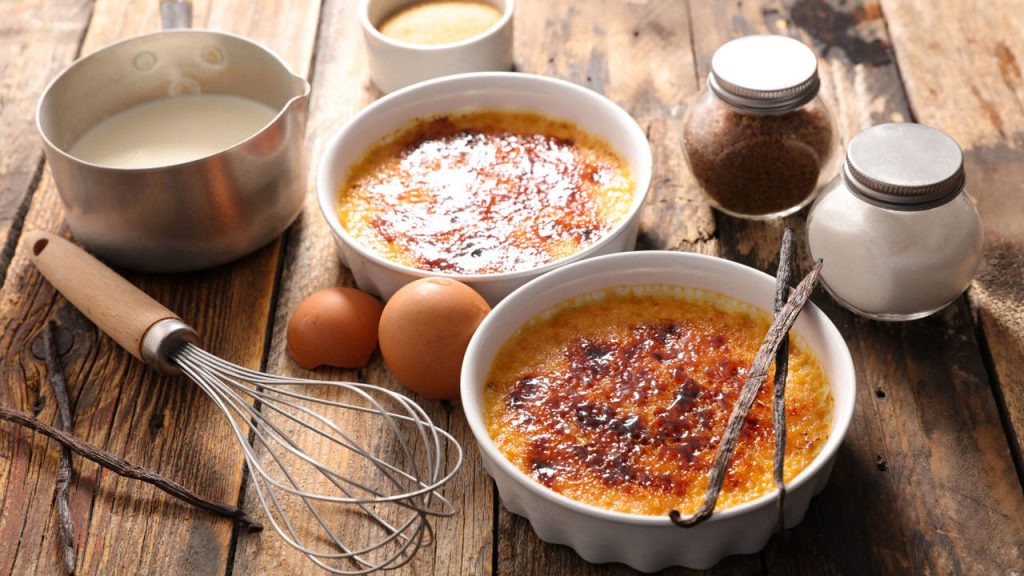In this recipe for Catalan cream, we have replaced cinnamon with vanilla, a healthy spice that can be used in a thousand ways in cooking. Like a creme brulee, but lighter.

- Catalan cream: vanilla recipe
- Origin of Catalan cream
- What is the difference between crema catalana and crème brulée?
Catalan cream is undoubtedly one of the best-known dessert recipes with a pastry cream base and, although it is often confused with French crème brûlée, being a burnt cream, it is prepared differently.
The traditional Catalan cream recipe is made with eggs, cornstarch, sugar and milk infused with lemon and cinnamon. Here we propose a variant in which we are going to replace cinnamon with vanilla and, instead of white sugar, we are going to use whole cane sugar. We will also tell you how to replace milk with a vegetable alternative if you prefer to avoid milk.
CREMA CATALANA: VAVANILLA RECIPE
This Catalan cream recipe is a proposal by the expert in vegetarian and healthy cuisine Mercedes Blasco. The use of vanilla instead of cinnamon brings the recipe closer to the French version of this dessert, the famous crème brûlée, but both the rest of the ingredients and the proportion are those of the Catalan recipe.
INGREDIENTS (SERVES 6):
- 1 liter of milk
- 1 lemon (its skin)
- 1 vanilla pod
- 6 beaten egg yolks
- 50 g cornstarch
- 250 g fine cane brown sugar
PREPARATION (30′ + 1 H. REST + 5′ GRATIN):
- Set aside a cup of milk to dissolve the starch
- Boil the remaining milk with the vanilla pod open in half and the lemon peel, and let stand.
- Reserve 50 g of sugar and mix the rest with the yolks until you get a fine texture. Add the previously strained milk and the unread starch and stir the mixture.
- Then cook the preparation in a water bath while stirring, always in the same direction, for five minutes, preventing it from boiling so that it does not cut.
- Distribute the cream in individual casseroles and let cool.
- Sprinkle with sugar and burn with a hot shovel or a small kitchen torch. You can also gratin them over high heat, so that the surface caramelizes.
NUTRITIONAL INFORMATION
- Calories: 341
- Protein: 9 g
- Carbohydrates: 50 g
- Fat: 12 g
- Cholesterol: 332 mg
HOW TO REPLACE MILK WITH VEGETABLE DRINK
Vegetable milks, such as barley or rice, can perfectly replace cow’s milk in this type of dessert recipes. Almond milk and hazelnut milk also provide an interesting touch. Soy milk, having a stronger flavor, is not as suitable, as it could alter the flavor.
Reduce boiling time by 5 to 2 minutes. This also prevents the cream from being cut.
Keep in mind that the nutritional content of the cream also varies.
ORIGIN OF CATALAN CREAM
The Catalan cream was born in Catalonia in the Middle Ages, as an evolution of custard, so it already appears in Catalan medieval recipe books.
There, today it is also known as crema de Sant Josep, because it is traditionally taken by San José, but it is a dessert that is never missing in traditional cuisine restaurants and that has even made its way into the most experimental cuisine, transformed, of course, with the most modern techniques.
In Catalonia it is not uncommon to find families who have a burner at home, be it a traditional burner or a small blowtorch, to be able to make homemade Catalan cream.
WHAT IS THE DIFFERENCE BETWEEN CREMA CATALANA AND CRÈME BRULÉE?
Crème brûlée is a French recipe and, like crema catalana, it also has a layer of burnt sugar on top that gives it a crunchy touch, hence its name (brûlée means “burned” in French). However, there are three differences that distinguish them:
- In the French recipe cream or cream is used, instead of milk as in the Catalan recipe.
- Another difference between crema catalana and crème brûlée is that crema catalana is usually made on a fire, while crème brûlée is baked in the oven in a bain-marie.
- The traditional Catalan cream milk is infused with lemon and cinnamon; In the crème brulée lemon is not used and, instead of cinnamon, vanilla is used.
In our version of the Catalan cream, we suggest you try the traditional Catalan recipe incorporating the vanilla touch of the crème brûlée.
VANILLA, A SPICE WITH MANY USES
The taste and aroma of genuine vanilla is sweet, so it is often used to prepare desserts and pastries. These are the tips of Mercedes Blasco to choose it well, use it in the kitchen and keep it.
WHERE TO FIND AUTHENTIC VANILLA
Whole pods can be purchased in herbalists, health food stores or select food stores.
The best pods have a flexible and shiny appearance and the most aromatic, known as “frosted vanilla”, are recognized by a light white veil that appears at their ends.
HOW TO KEEP IT
When you have your authentic vanilla pods, a nice way to store them inside a jar of cane sugar inside the jar where the tea, cocoa, cornstarch is stored, so that, at the same time that it is preserved, it aromatizes it. In the same way you can arrange a pod to perceive its intense aroma.
HOW TO USE VANILLA IN THE KITCHEN
Its flavor is often associated with chocolate, and is also used in the preparation of ice cream, soft drinks, slushies and sorbets, and even in liqueurs and perfumes.
A classic way to use it is by cutting a small piece of the pod and opening it in two. Then a cup of boiling milk, either cow, soy, oatmeal or rice, is poured on top of it and allowed to stand five or ten minutes before straining it. Once scented milk is used to prepare custard, rice desserts or custards.
It is also exquisite if combined with lemon rind, or with other sweet spices such as cinnamon or cloves. This is what we have done in our vanilla Catalan cream: we have combined it with lemon and we have used it to infuse the milk as explained above.
Vanilla also intensifies the flavor of fruits. Therefore, it is interesting to include it in the preparation of compotes and fruit cakes. It is exquisite with apples, pears or quinces cooked or roasted.
As it is a strong and penetrating spice, once the pod is used, it can be gently washed in hot water and dried, to reuse it a couple of times.
You can also prepare aromatic oil for cooking. In this case it is advisable to use a mild-tasting oil, such as sesame. A pair of pods open longitudinally in a glass bottle are placed, filled with the oil and left to macerate for about fifteen days. After that time the oil can be used in the preparation of buns or for frying, for example, sweet fritters.








